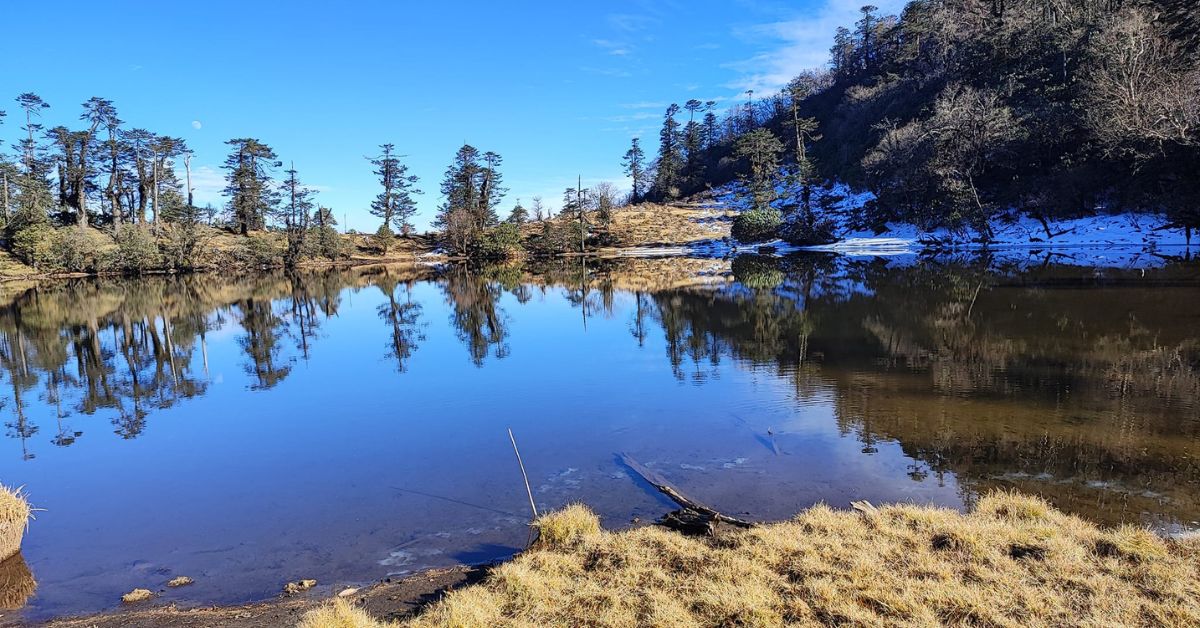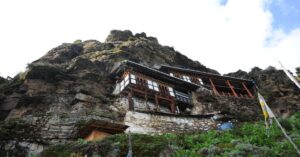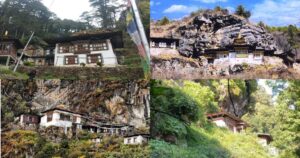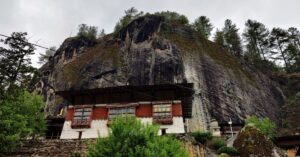Jo Bay Tsho is a sacred, hidden lake that stretches approximately 300 meters in length and 200 meters in width, nestled high in the mountains along the border of Sombaykha and Gakiling Gewogs in Haa Dzongkhag.
Bay Tsho, which translates to “hidden lake,” is linked to a local legend surrounding Paro Pangbe Lam Terton Sherab Mebar and his followers, who are said to have traveled there to extract gold from the golden pillar hidden within the lake.
This hidden lake, accessible via a two-day trek spanning over 25 kilometers, is well worth the effort, offering stunning landscapes of snow-capped mountains and lush forests. However, the lake is usually shrouded in mist, and you must be fortunate enough to enjoy its breathtaking views.
How To Reach Bay Tsho
The journey to reach Jo Bay Tsho begins with an 84-kilometer scenic drive from Haa to Sangbaykha Drungkhag, followed by a 20-kilometer drive upstream to Mochhu Village, which takes around an hour. From Mochhu, you’ll embark on a two-day trek covering a distance of around 25 kilometers through forests, alpine meadows, and highland pastures before reaching the hidden lake.
Also Read: How to reach Domendrel Tsho, a Spiritual Journey to Mandala Offerings of Gyalse Tenzin Rabgye.
Historical Significance of Jo Bay Tsho
According to the legend of Jo Bay Tsho, Bay Tsho, meaning a “hidden lake,” is connected to the Paro Pangbe Lam Terton Sherab Mebar. Folklore has it that the Terton and his followers visited Baep Tsho to extract golden pillars from the lake for the construction of Paro Dzong. At the site, using his mystical powers, the Terton transformed himself into a frog and drew the lake into his mouth for his followers to discover golden pillars.
However, his followers, driven by greed, began removing more than the permissible limit. When the Terton attempted to stop his followers, the lake escaped from his mouth and submerged all his followers. Terton then grabbed a pair of cymbals, transformed himself into a sparrow, and ran to escape himself. But the mermaid of Baep Tsho took the form of a hawk and chased him.
Also Read: How did Drakey Pangtsho, the Treasure Lake of Guru Rinpoche on the Lap of Jowo Drake, get its name?
When the Terton reached another lake called Nub Tshona Patra, he threw one of the cymbals into the lake. Today, we can only see one of the cymbals in the Paro Dzong.
Finally, their chase reached Tergola, where Jo Tergo, the local deity, intervened. They agreed that neither the descendants of Terton nor the mermaid of Baep Tsho will ever cross the Tergo La again. According to this myth, it is believed that people from beyond Tergola can’t marry those from Paro Pangbesa. Even today, the communities of Sangbaykha and Samtse offer prayers to Bay Tsho for the blessings and protection.
Also Read: The Historical Significance of Kabji-Hoka Tsho, a Lake with an Opening to Stop Overflowing
Jo Bay Tsho Trek
Jo Bay Tsho Trek is a two-day trek that begins at Mochhu and ends at Youkha village, covering a distance of around 25 kilometers.
Day 1: Mochu to Tinsokey
The trek begins at Mochhu after visiting an old temple that houses 1000 statues of Guru Rinpoche, setting a deeply spiritual tone for the trek. The trail ascends through thick bamboo groves and forests, occasionally opening wide grazing lands.
After hiking for six hours, trekkers will reach Tinsokey, a spacious pastureland that is ideal for camping. Trekkers can either stay in a simple two-room cottage that accommodates 8-10 people or pitch their own tents.
Also Read: Dangling Tsho, the Sacred Summer Abode of Meme Dangling
Day 2: Tinsokey to Jo Bay Tsho and descent to Youkha Village
The second-day trek begins with a 3-kilometer uphill climb through open pastures to the hilltop, followed by another 3 kilometers of gentle descent before reaching Jo Bay Tsho.
If you are fortunate to arrive at the lake when it’s clear, the lake is mesmerizing. A small area is designated for offering, where trekkers can light incense, butter lamps, or offer Serkem, a liquor for libation. However, trekkers must refrain from pouring milk into the lake.
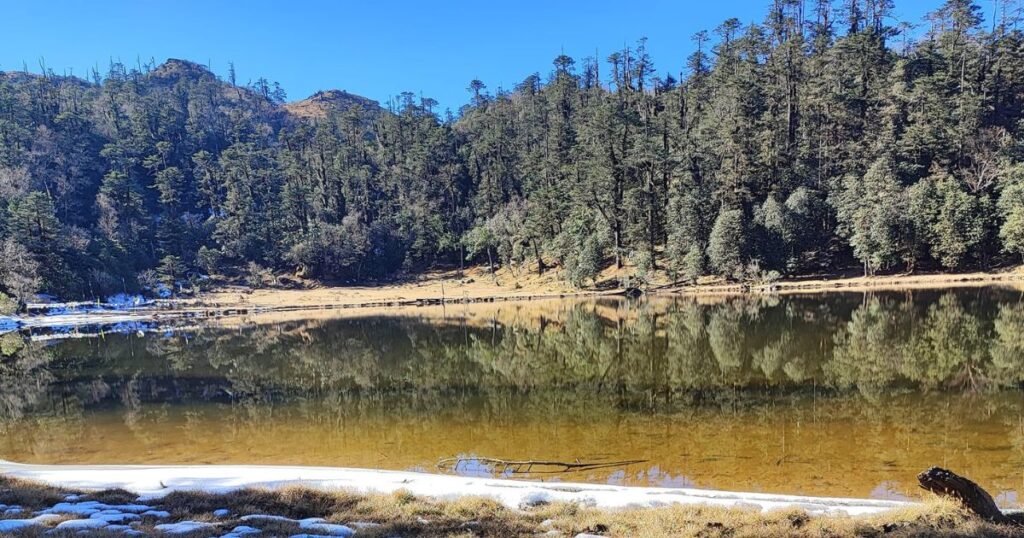
Take a moment to soak in the beauty and stillness of the surroundings. Make not just TikTok reels but lasting memories of this sacred place, because you might not reach such a place again anytime soon.
The journey back involves descending through dense rhododendron forests and thick bamboo groves. The final stretch, though steep and winding, takes the trekkers down to the end-point, Youkha village under Gakiling Gewog. In Youkha village, the trekkers can choose to enjoy the region’s traditional Tongba, a millet-based alcoholic drink served in a bamboo container with a straw.
From here, the drive back to Haa Valley takes approximately four hours, marking the end of an unforgettable trek to Jo Bay Tsho.
Also Read: Zhemgang Kheng Buli Tsho, a Promised Lake of Buli Moenmo Kuntu Zangmo
Best Time to Trek to Jo Bay Tsho
The best times to trek to Jo Bay Tsho are from February to April and from October to December, when the weather is most favorable and the trails are in their best condition. Although trekking during the monsoon months is still possible, the trails may be wet and slippery. The winter season, on the other hand, is not recommended due to extreme cold temperatures and heavy snowfall. You can visit the major sacred lakes in Haa with the Bhutan Pilgrimage Package.
Also Read: Mebar Tsho, the Burning Lake, where Pema Lingpa discovered Hidden Treasures
Places to Explore in Haa
Rangtse Ney: A sacred abode of Guru Rinpoche located in Chego village under Haa Dzongkhag at an altitude of 879 meters above sea level.
Lhakhang Nagpo: Also known as the “Black Temple”, it is a one-story temple founded by Songtsen Gampo in 659 CE in the Haa Valley.
Shelkar Drak Lhakhang: A small temple built on a cliffside in Haa, founded by Choglay Jigme Tenzin, the sixth speech incarnation of Zhabdrung Rinpoche.
Lhakhang Karpo: Also known as the “White Temple”, it is a one-story temple founded by Songtsen Gampo in 659 CE to subdue a demoness in the Haa Valley.
Enjoyed reading this blog?

